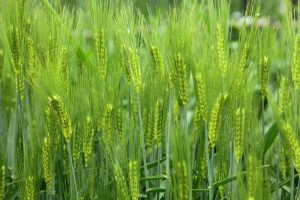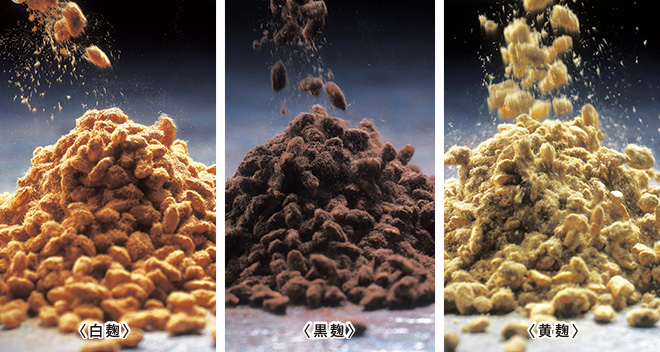Characteristics and Appeal of Barley Shochu
Barley shochu (mugi shochu) is a type of honkaku shochu made from barley as its main ingredient. Known for its mild aroma and smooth taste, it is particularly celebrated for being one of the most drinkable types of honkaku shochu. While it lacks the intense character of sweet potato shochu (imo shochu), its toasty barley aroma and refined flavor continue to captivate many enthusiasts.
1.Characteristics of the Ingredients
The primary ingredient in barley shochu is typically two-row barley, which is also used in beer production. Two-row barley is high in starch and contains an optimal amount of protein, making it ideal for shochu production. In recent years, some breweries have also begun using hadaka mugi (naked barley). Without an outer husk, naked barley can extract more of the grain's inherent flavor. Additionally, its higher protein content compared to two-row barley results in a deeper, richer taste.


2.Role and Characteristics of Koji Mold
White koji is predominantly used for barley shochu production. It generates moderate amounts of citric acid, contributing to a clean and light flavor. Some breweries, however, experiment with black or yellow koji, creating shochu with varied characteristics. White koji tends to produce crisp and refreshing flavors, while black koji delivers a richer, more robust profile.

(Left :white koji, Center :black koji, and Right :yellow koji)
3.Key Production Regions: Oita Prefecture
Barley shochu production is concentrated in northern Kyushu, with Oita Prefecture standing out as a major production area. Across the prefecture, diverse brands with unique characteristics are crafted.
Hita City: Produces light and crisp shochu using pristine underground water.
Usa City: Known for smooth and toasty shochu varieties.
Kunisaki Peninsula: Offers deeply flavored products made with mineral-rich water.
Notable brands include "Nikaido," "Oimatsu," and "Takaiya."
4.Characteristics of Iki Shochu
Another noteworthy barley shochu is Iki Shochu, produced on Iki Island in Nagasaki Prefecture. Recognized as a Geographical Indication (GI), Iki Shochu uses a unique recipe combining barley and rice koji. Its production relies on the island’s high-quality groundwater and traditional methods, resulting in a mellow and harmonious flavor.
5.Barley Shochu in Fukuoka Prefecture
Fukuoka is another important barley shochu region. Known for its barley cultivation, Fukuoka’s Chikugo area leverages abundant water resources to produce fine shochu. Urban breweries in Hakata are also pioneering innovative approaches, blending tradition with modern techniques.
6.Flavor Characteristics
The flavor of barley shochu varies by production method and ingredients but is generally characterized by a gentle aroma and soft taste. The toasty, barley-derived fragrance is subtle yet refined, and aging enhances its complexity. The flavor profile offers a smooth, balanced mouthfeel with moderate sweetness and umami, making it approachable and versatile.
7.Influence of Distillation and Aging
Distillation methods play a crucial role in defining a product’s character.Atmospheric Distillation: Highlights a robust, toasty aroma and deep flavor.Vacuum Distillation: Produces a clean aroma and softer taste.Newly distilled shochu has a fresh barley scent, while aging develops its smoothness and complexity. Long-aged barley shochu is particularly appreciated for its rich taste and aromatic depth.
8.Ways to Enjoy Barley Shochu
Barley shochu’s versatility allows for various serving styles:
Watered Down (Mizuwari): The most common method, preserving the barley’s aroma and flavor.
Hot Water Mix (Oyu-wari): Enhances aroma and smoothness, popular in winter.
On the Rocks: Offers a refreshing drink with a crisp finish, ideal for summer.
9.Pairing with Cuisine
Barley shochu pairs exceptionally well with a wide range of dishes. Its mild taste complements not only Japanese cuisine but also Chinese and Western dishes. It pairs particularly well with grilled or simmered dishes, as well as dumplings, grilled meats, and cheese-based recipes.
10.Contemporary Appeal
Barley shochu’s mild flavor and versatility make it popular among a wide demographic. By maintaining traditional techniques while incorporating innovative approaches, breweries continue to craft unique products. Additionally, the nutritional benefits of barley have gained attention, aligning with the growing health-conscious trend.
11.Conclusion
Barley shochu continues to evolve, balancing tradition with innovation. Its rich flavors and cultural significance make it a proud representative of Japan’s shochu heritage, enchanting people worldwide. As breweries embrace new possibilities while honoring time-tested methods, barley shochu will remain a beloved distilled spirit, treasured for its uniqueness and versatility.



